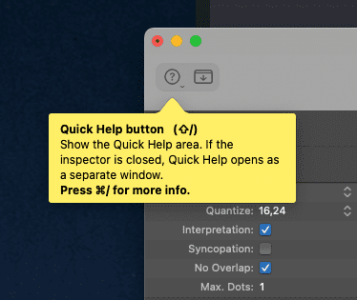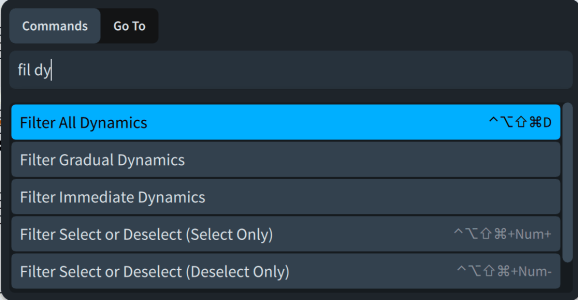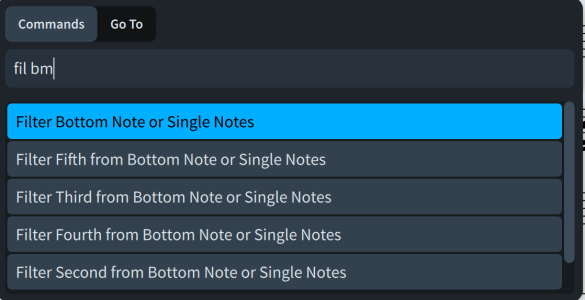syrinx
Senior Member
For that example, in Sibelius, I even just select the bar and hit delete. Quick and easy.Actually, in Sibelius you can select the tie and eight note together at the same time - so still fewer steps
For that example, in Sibelius, I even just select the bar and hit delete. Quick and easy.Actually, in Sibelius you can select the tie and eight note together at the same time - so still fewer steps
I’ll be the first to say I think the ribbon UI paradigm is a bit old school, but there’s an aspect of it in terms of organizing functions that really made it easy for me to figure stuff out in Sibelius. I really like Dorico’s UI, but a lot of stuff is hidden in properties or preference windows (ex. text size for a particular style or staff/note spacing). And then they rely on icons instead of text, so from an immediacy standpoint, it can be difficult unless you are very familiar with all the icons.I guess the reason why Dorico (or Sibelius users, Logic users, Finale users etc) users not always agree in how well Dorico (etc) work for composing is that there are several ways to compose using a score DAW or score app (or DAW with a built in pro, advanced score editor – which I think we'll see a lot of the coming decade).
Much of this could be improved if the developers of such apps implemented proper support for all possible, relevant ways to compose suing their software.
If Dorico would have introduced these changes, many Dorico users would certainly complain less:
- Contextual menus for everything
– Key commands for everything
- Menu options for everything
- Proper Help functionality for everything:

Also, I really like the Jump bar options that I think was introduced to Dorico 4 (press J). You can easily type in what you want without even having to remember any of the shortcuts using J. If you forget one of the shortcuts, just press J and type in what you want and it'll come up.Well, fortunately they are all pretty easy to remember, at least for me in the English language version – D for dynamics, T for tempo, M for meter, C for clefs, etc. And then once I'm in there all I have to do is type a couple letters and it auto-completes the rest for me. Super fast workflow, no additional load on my brain. So in this way, I feel like popovers are the "keys to the kingdom" from which I do practically everything in the software, without the need for memorizing all kinds of new and complex shortcuts. I think it's the best part of Dorico because you don't actually have to remember anything, it's just an extension of existing language.
But then again, I cannot speak to how this experience works in the other language versions, but I figure it's the same.
If you have the system track on by default, it's equally easy to delete just one bar.For that example, in Sibelius, I even just select the bar and hit delete. Quick and easy.
Just press J and search for what you want, it's pretty good..but a lot of stuff is hidden in properties or preference windows


I was not referring to deleting the actual bar. Rather, just hitting delete/backspace to clear the bar. It felt like people were explaining how to delete an eight note with a tie in a much more "academic" way in Sibelius than what is necessary.If you have the system track on by default, it's equally easy to delete just one bar.
The Jump Bar is even more powerful than that. First, if you don't type anything into it, it will do the last command you executed with it which is great if you need to do repetitive tasks. Just trigger the command once with the jump bar and after that it's just J and Enter.yeah 'J' is pretty awesome. If you don't know where something is, just start typing a few letters and it will pop-up, hit enter and it will take you right to where it exists in the menu preferences. Also handy for complex filtering tasks. So you really don't have to memorize anything. Let's say you want to filter all dynamics... you can just hit 'J' and all I have to type is 'fil dy' and it's the first thing that comes up, never even have to leave my keyboard -

I also really love quickly filtering individual notes in chords this way, a lot easier than assigning and memorizing key commands -

This is also really handy when you know what something is called but don't know the key command for it, since it will tell you on the right side. Other nice ones are stuff like inversion and rotation, just start typing 'rot' or 'inv' and you'll get a few options to mix notes up for fresh material. Between the jump bar and popovers I love that I can stay in the creative zone and don't have to dig around in contextual menus and panels searching for something, potentially losing my train of thought.
Wow, I never knew about the "=xy" trick! Cool stuff. Just assigned "filter notes by pitch" to "fn"The Jump Bar is even more powerful than that. First, if you don't type anything into it, it will do the last command you executed with it which is great if you need to do repetitive tasks. Just trigger the command once with the jump bar and after that it's just J and Enter.
Second, on complex commands once you've found them in the jump bar you can type "=xy" without the quotes behind it. Next time you open the jump bar, you type xy into it and it will trigger that command. Eg. No need to type fil dy as per your example above but I made it fd. Or ft, f2, etc. For filtering top notes, 2nd notes etc. This is a simple yet incredibly powerful tool that can make you incredibly fast with the jump bar.

You can exactly type that into the shift-I popover.Or really basic transpose, you want all your f naturals to be f#, so with your passage selected just invoke J and type "f to f#" or some kind of simplified easy syntax like that.
Never knew you could do that with shift+I! cool. do you happen to know of a way to filter specific articulations, like if you have several staves selected and want to filter all staccato to switch to staccatisimo? that would be handy but I haven't figured out a way.You can exactly type that into the shift-I popover.
Well almost exactly. The syntax is f=f#
Not yet, but I have requested it so hopefully will show up in future versions...do you happen to know of a way to filter specific articulations, like if you have several staves selected and want to filter all staccato to switch to staccatisimo? that would be handy but I haven't figured out a way.
Aside from doing a rectangle select in the piano roll view, I don't think so, although the searches I did before said this was supposed to be coming. But the rectangle select works well for that. You may just have to zoom out vertically and horizontally in case it is zoomed in too much so that you can select the entire area you want in one go.I see Dorico has a dialog for selecting / unselecting specific notes, but is there a way to select all notes below or above a specific note? Without typing in each eligible note into that dialog?
AFAIK, there's no option to export MIDI with no CC data, but unless you are adding CC data manually yourself by drawing in the CC lanes, all CC data is added on-the-fly by the expression map, except for the initial CC7 set by the MIDI volume slider. So, if all tracks are set to use the "default" expression map, which uses only velocity, then the export shouldn't include any other CC's unless you've added them yourself. I imagine probably changing templates from "NotePerformer" to "Silence" so that you no longer hear the score probably results in this and then doing the export should handle this, but I'm not 100% sure. If not, you can probably remap all tracks to some dummy vsti set for "Default" expression map and then export.One additional question is whether it's possible to export MIDI, but without cc data? I don't envision myself importing any of my libraries into Dorico, but just using Note Performer alone.
whether it's possible to export MIDI, but without cc data? I don't envision myself importing any of my libraries into Dorico, but just using Note Performer alone.
The HALion Sonic Selection (e.g the non-HSO, non-Iconica sounds that you get with the free version of Dorico) are all General MIDI with no keyswitches or additional CC data (beyond CC1 for dynamics, and things like panning).I imagine probably changing templates from "NotePerformer" to "Silence" so that you no longer hear the score probably results in this and then doing the export should handle this, but I'm not 100% sure. If not, you can probably remap all tracks to some dummy vsti set for "Default" expression map and then export.
Will dorico export MIDI if you choose "Silence" as the playback template?The HALion Sonic Selection (e.g the non-HSO, non-Iconica sounds that you get with the free version of Dorico) are all General MIDI with no keyswitches or additional CC data (beyond CC1 for dynamics, and things like panning).
If you want to export with no 'extraneous' MIDI data, using the HSS Playback Template is your best bet.
Noteperformer uses a tonne of CCs for all its magic.
A quick test reveals I get a MIDI file with 4 items in it: SMPTE, Time sig, tempo and key sig. No notes. (In Dorico, all the notes have a velocity of Zero.)Will dorico export MIDI if you choose "Silence" as the playback template?


